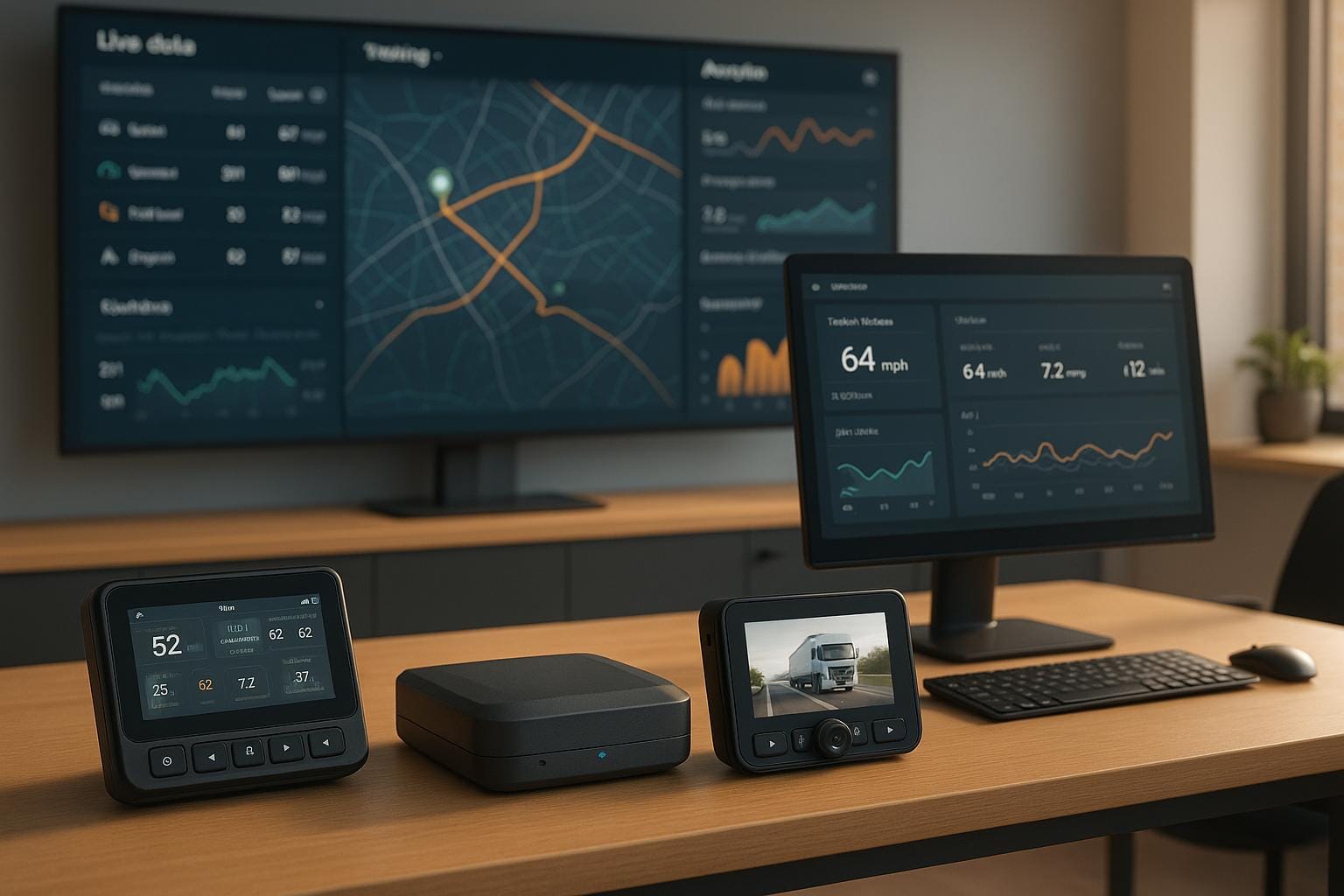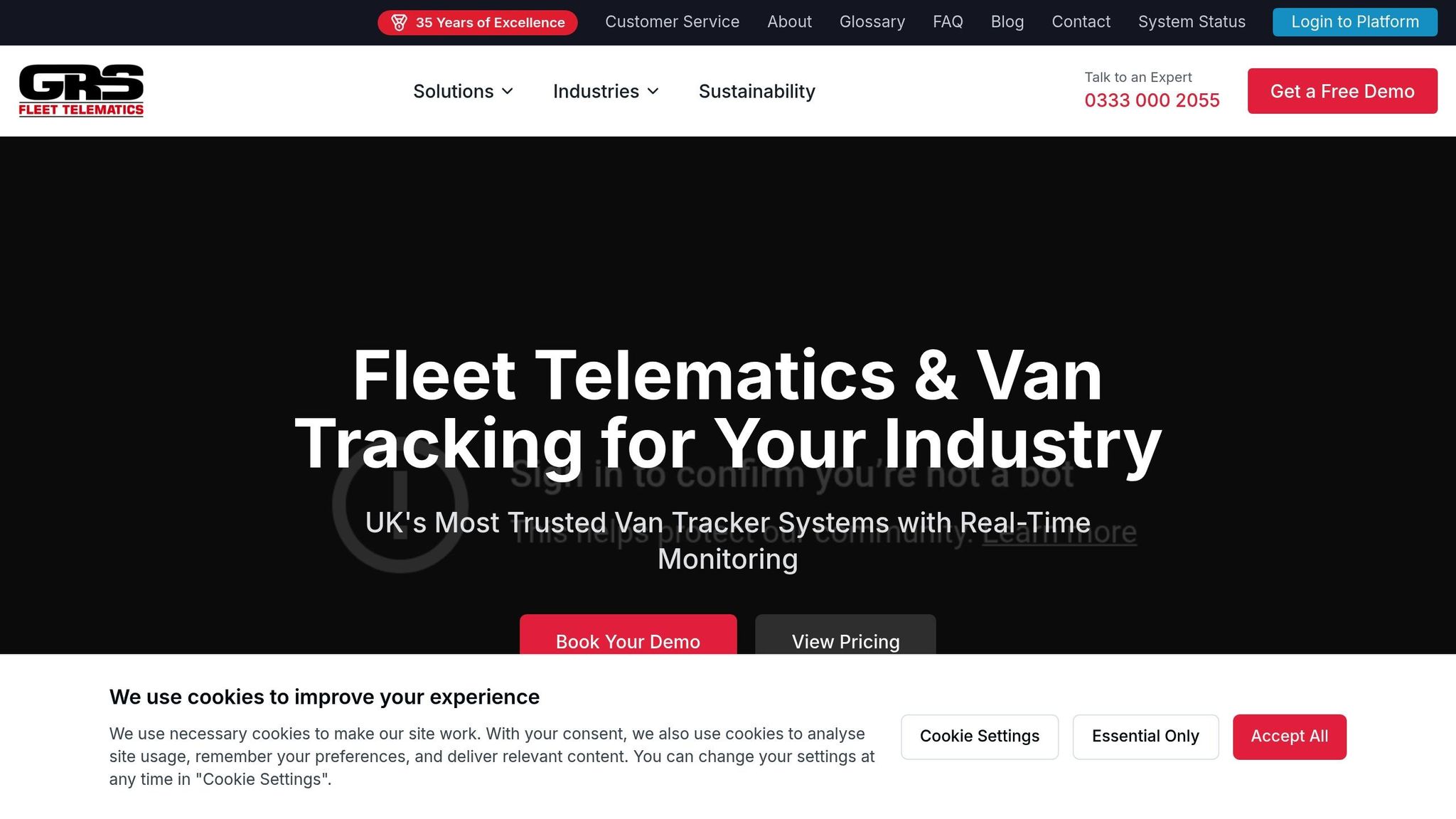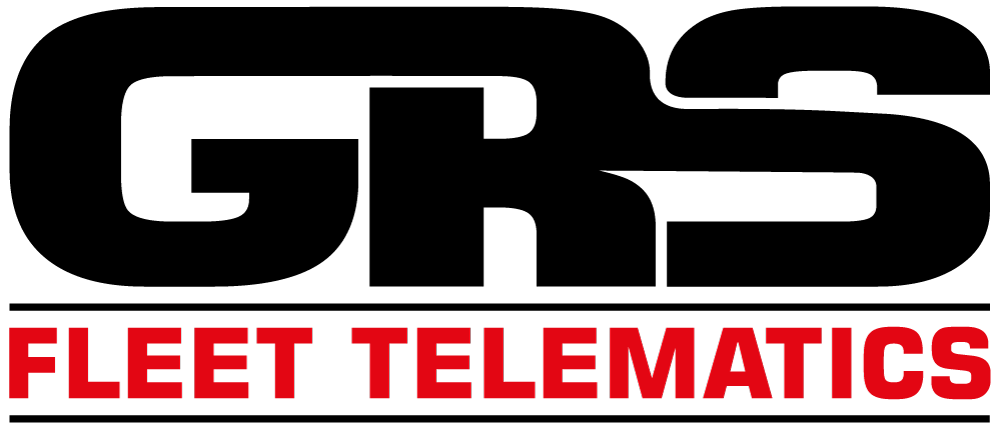Hardware Integration in Fleet Telematics: Explained
Explore how integrated hardware in fleet telematics enhances security, efficiency, and compliance for UK operators, transforming fleet management.

Fleet telematics has evolved far beyond basic vehicle tracking. Today, it integrates hardware like GPS trackers, sensors, and dash cameras with software to centralise data for better fleet management. This approach helps UK operators improve security, reduce costs, and comply with regulations like London's Direct Vision Standard (DVS).
Key Points:
- Security: Dual GPS/RF trackers and immobilisers reduce theft risks, with recovery rates reaching 91%.
- Efficiency: Telematics systems cut fuel costs (up to 24%) and maintenance downtime (up to 45%).
- Driver Safety: Real-time monitoring and AI-powered cameras address risky behaviour, fatigue, and distractions.
- Compliance: Tools ensure adherence to UK regulations, including driver hours and safety standards.
- Connectivity: Options like CAN interfaces, 4G networks, and satellite systems suit urban and rural fleets.
- Challenges: Operators face hurdles like hardware compatibility, GDPR compliance, and ongoing maintenance.
GRS Fleet Telematics supports fleet operators with tailored hardware packages, transparent pricing (£7.99/month per vehicle), and UK-wide installation. Their solutions simplify integration, ensuring secure, efficient, and compliant fleet operations.
Mapon Express Academy | Telematics Hardware

Common Hardware Used in Fleet Telematics
Fleet telematics relies on essential hardware that plays a crucial role in vehicle monitoring and management. These tools help UK fleet operators make informed decisions about technology and security. Below are the main components that support fleet operations.
GPS Trackers and Dual-Tracker Systems
GPS trackers are at the heart of telematics, using satellite signals to provide real-time vehicle locations across the UK. They enable efficient routing, improve dispatch operations, and allow for quick responses to incidents.
Dual-tracker systems take this a step further by combining GPS with radio frequency (RF) tracking. This redundancy boosts vehicle recovery rates to as high as 91%, helping to reduce theft-related losses and potentially leading to lower insurance premiums.
Sensors and Dash Cameras
Sensors, such as accelerometers and gyroscopes, monitor vehicle movement and driver behaviour. These tools help assess performance, identify risks, and ensure compliance with UK regulations.
Dash cameras, now a common feature in UK fleets, serve as valuable tools for recording incidents. They provide evidence for resolving disputes and preventing fraud. With advancements like 4G and 5G connectivity, these cameras now offer live streaming and real-time alerts, aligning with HSE guidelines and supporting insurance claims.
Immobilisers and Security Hardware
Immobilisers enhance vehicle security by preventing engines from starting without proper authentication. Commonly used in high-risk or high-value vehicles, they meet insurance standards and significantly lower theft-related losses. Some systems even allow remote activation, enabling operators to disable a stolen vehicle immediately.
When paired with alarms and remote locking systems, immobilisers create a strong security framework. Professional installation services available across the UK ensure these systems perform reliably and effectively.
How Hardware Integration Works with Telematics Systems
For UK businesses aiming to get the most out of their telematics investment, understanding how hardware works with fleet management software is key. The integration process relies on standardised protocols and data systems working together to provide a clear picture of fleet operations. This lays the groundwork for understanding how connectivity and data management come together in telematics.
Integration Protocols and Connectivity
Modern telematics systems rely on various communication methods to ensure smooth data transfer between hardware and software. CAN (Controller Area Network) interfaces connect directly to a vehicle’s internal systems, providing access to critical data like engine diagnostics and fuel usage.
USB and RS232 interfaces add further connectivity options for external devices, such as dash cameras. Meanwhile, Bluetooth Low Energy (BLE) technology offers wireless connections for tools like driver ID tags or mobile sensors, simplifying installation and ensuring reliable communication.
For data transmission, GPRS networks handle basic tracking functions, whereas 4G cellular networks support more advanced needs, such as live video streaming from dash cameras. In areas with limited cellular coverage, satellite communication ensures uninterrupted connectivity, even in remote parts of the UK.
The choice of connectivity depends on operational needs. Urban fleets often benefit from fast 4G networks, while rural operations may require satellite systems as a backup. Fleet operators should carefully assess their coverage requirements and data demands when deciding on integration options.
Centralised Data Management
Once the connectivity protocols are in place, the system aggregates data centrally, turning raw inputs into actionable insights. Telematics devices gather information via sensors, engine diagnostics, and GPS, converting it into usable metrics like vehicle performance and location data. This information is stored on the telematics device before being transmitted to central servers, where it becomes accessible through fleet management software.
This centralisation transforms raw data into meaningful insights. For example, updated vehicle locations help dispatchers optimise routes, while engine diagnostic codes can trigger alerts for preventive maintenance. Additionally, driver behaviour data highlights areas for training and ensures compliance with regulations.
Fleet management software brings these data sources together, offering real-time visibility into fleet operations. Through intuitive dashboards, managers can monitor vehicle locations, driver performance, maintenance schedules, and operational costs - all from one platform. Mobile apps enhance this functionality, giving field supervisors and drivers access to critical information while on the move.
Data security is a top priority throughout this process. UK fleet operators must ensure their systems comply with GDPR regulations and use strong encryption protocols to protect sensitive information. The growing confidence in secure, integrated telematics systems is reflected in market projections, with the global telematics market expected to grow from $59 billion in 2020 to $179 billion by 2028.
Achieving successful integration requires careful planning and professional support. Fleet operators should confirm that their telematics provider offers full integration services, including compatibility checks with existing systems and ongoing technical assistance. This ensures seamless operations and maximises the return on investment across all fleet management activities.
Key Benefits of Hardware Integration in Fleet Telematics
When fleet managers in the UK invest in integrated hardware systems, the rewards go far beyond basic vehicle tracking. By combining advanced sensors, GPS technology, and smart software, fleets can achieve measurable improvements in security, operational efficiency, and driver safety. These systems not only protect assets but also streamline operations and promote safer driving.
Enhanced Vehicle Security and Theft Prevention
Vehicle theft remains a pressing concern for UK fleets, but hardware integration offers a multi-layered defence system that significantly reduces risks and aids recovery.
Dual-tracker systems, which use two independent tracking devices placed in separate locations within a vehicle, achieve a 91% recovery rate for stolen vehicles - far exceeding industry norms. Paired with immobilisers that block unauthorised engine starts, these solutions create a robust theft deterrent.
Geofencing adds another layer of protection by setting virtual boundaries around specific areas. If a vehicle moves beyond these zones, instant alerts are triggered, allowing for swift action to prevent theft.
In addition to safeguarding vehicles, these advanced security measures often lead to cost savings. Many insurance companies offer lower premiums for fleets equipped with enhanced security features, providing long-term financial benefits that can help offset initial investment costs.
Boosted Efficiency and Cost Reductions
The benefits of hardware integration extend well beyond security. By streamlining operations, UK fleets have reported significant cost reductions in 2024, including 24% savings on fuel, 22% on labour, and 21% on maintenance.
Fuel efficiency is one of the most immediate advantages. Telematics hardware tracks engine performance, idle times, and driving habits in real-time. For example, a van idling for just one hour burns 1.9 litres of fuel, costing approximately £3.50 and emitting nearly 5kg of CO2. Bates Office Services saw tangible results, with Operations Director Ben Hensby sharing:
"We've seen almost 13% savings on our monthly fuel bill since introducing Lightfoot. It's the clearest piece of ROI and the easiest sell to the board I've probably ever had."
Predictive maintenance is another game-changer. Sensors continuously monitor critical vehicle systems like engine diagnostics, brake wear, and tyre pressure, alerting managers to potential issues before they escalate into costly repairs. This proactive approach can cut vehicle downtime by up to 45%, a significant saving when the average cost of an out-of-service van is £800 per day.
Route optimisation further enhances efficiency. By leveraging integrated GPS and traffic data, vehicles can follow the most fuel-efficient and timely routes, improving delivery schedules and cutting fuel consumption. Additionally, automated expense management simplifies administrative tasks, ensuring compliance with HMRC requirements while reducing paperwork.
Driver Safety and Compliance Monitoring
Ensuring driver safety is both a moral responsibility and a business priority, especially since around one-third of UK traffic collisions involve someone driving for work. Integrated hardware systems offer a comprehensive suite of tools to protect drivers and ensure compliance with regulations.
Real-time monitoring tracks risky behaviours such as harsh braking, rapid acceleration, and sudden lane changes. Immediate feedback helps drivers adjust their habits, reducing the likelihood of accidents. European fleets using advanced telematics have seen a 43% improvement in driver safety and a 36% reduction in incidents of speeding and harsh driving.
Video telematics adds another layer of safety by capturing real-time footage of driver actions. Modern AI-powered systems streamline the review process, reducing the need for manual video analysis by up to 99%. These systems also provide real-time alerts, enabling targeted driver coaching to address risks proactively.
Fatigue and distraction monitoring tackles two major causes of accidents, as driver fatigue and distractions account for over 20% of road incidents in the UK. AI-driven systems can detect signs of drowsiness or inattention, allowing interventions before accidents occur.
Compliance monitoring ensures adherence to UK driving regulations, including working time directives and proper use of specialised equipment. Driver ID fobs integrated with telematics systems verify licence validity, while automated tracking of hours helps prevent breaches of driving time rules.
Lone worker safety is another critical area. Ringway Jacobs, for instance, implemented a video-enabled driver protection system across 163 vehicles. Head of Fleet David Bonehill explained:
"Health, wellbeing and safety are at the heart of everything we do, so our aim is to always provide a safe working environment for our employees. This latest initiative has not only increased compliance of our lone worker processes, but also extended and enhanced the levels of protection we can provide our drivers."
The financial benefits of improved safety are clear. British fleets using telematics solutions reduced their accident-related costs by an average of 28% in 2024, showing how safety measures can deliver both human and economic advantages.
Challenges and Considerations for UK Fleet Operators
While integrated hardware brings many benefits, it also presents challenges that require careful planning and management. Fleet operators in the UK face several practical difficulties that need strategic solutions to ensure smooth implementation and long-term success.
Compatibility and Installation
One of the biggest hurdles is ensuring hardware compatibility across a wide range of vehicles and existing systems. Mixed fleets - comprising small vans, heavy goods vehicles, and electric delivery vehicles - often have varying electrical setups, dashboard designs, and mounting needs. These differences can make uniform installation tricky and lead to fragmented data, complicating analysis. Additionally, installation errors can create further challenges in maintaining data security and system reliability.
To address these issues, professional installation is crucial. Collaborating with experienced installers who understand the complexities of different vehicle types can help avoid costly mistakes. These specialists are skilled in deploying fleet management tools, such as tracking systems, cameras, and sensors, and stay updated on evolving technologies and methods.
Data Security and GDPR Compliance
Data protection is a key concern for fleet operators, especially under the UK GDPR, which has been in force since 1 January 2021. Telematics systems collect a range of personal data, including vehicle location, driver identification, driving habits, and route histories. This brings significant responsibilities to ensure compliance with data protection laws.
UK GDPR requires transparent and secure handling of telematics data, with a clear justification for its collection and use. In many cases, processing data based on legitimate interest is permissible, provided it is well-documented and balanced. However, if vehicles are used for personal purposes or tracking occurs outside work hours, explicit driver consent may be necessary.
Fleet operators must adopt strong technical and organisational measures to safeguard data. This includes encrypting information, restricting access, conducting regular audits, and having a clear response plan for breaches. Transparency is equally important - managers should clearly explain why data is collected, how long it will be stored, and who can access it. Embedding GDPR principles such as fairness, transparency, data minimisation, and accountability into daily operations is essential. For businesses with cross-border operations, appointing an EU representative might also be required if they monitor individuals within the EU. Maintaining these high standards over time is critical, as any lapse could lead to compliance issues or reputational damage.
Maintenance and Support Requirements
The ongoing maintenance and support of telematics hardware is another challenge often underestimated by fleet operators. These systems require specialised expertise for routine upkeep, software updates, and troubleshooting connectivity issues. Over time, ensuring the seamless integration of various hardware components also demands consistent monitoring.
Regular servicing by qualified engineers can minimise downtime and maintain system reliability. However, finding technicians with the right telematics expertise can be particularly challenging in remote areas. Delays in addressing hardware failures can compromise tracking accuracy and expose fleets to security and compliance risks.
Reliable support services are essential for resolving technical issues, managing software updates, and handling hardware malfunctions promptly. Additionally, tracking warranty periods, scheduling preventive maintenance, and coordinating repairs across multiple devices can become an administrative burden, requiring dedicated resources. Staff training also plays a critical role - employees should be equipped to identify potential hardware problems and liaise effectively with support teams. Any delay in resolving issues not only risks operational inefficiencies but can also lead to financial losses, undermining the benefits of a well-integrated system.
How GRS Fleet Telematics Supports Hardware Integration

GRS Fleet Telematics has developed solutions to tackle the common challenges fleet operators face when integrating hardware. Their offerings combine versatile hardware options, professional installation, and ongoing support to ensure smooth implementation across a variety of UK fleets. By focusing on compatibility, cost, and continued assistance, they provide a complete integration package that aligns with operational needs.
Advanced Hardware Options
GRS Fleet Telematics offers three tailored hardware packages to meet the diverse security and tracking needs of fleet operators:
- Essential Package (£35): This includes a single wired tracker, providing reliable real-time tracking for basic fleet monitoring. It's an affordable option for straightforward vehicle tracking needs.
- Enhanced Package (£79): Designed for greater security, this package includes a primary tracker and a secondary Bluetooth backup device. The dual-tracker system ensures redundancy, offering continued monitoring even if one device is compromised.
- Ultimate Package (£99): This top-tier option combines both tracking devices with an immobilisation feature, delivering maximum security for high-value vehicles or fleets operating in areas prone to theft.
These hardware options are designed to work seamlessly with the varied vehicle types found in UK fleets, from small vans to heavy goods vehicles. They are compatible with different electrical systems and dashboard configurations, effectively minimising the common compatibility issues faced by mixed fleets.
Affordable, Transparent Pricing
GRS Fleet Telematics adopts a straightforward pricing model that eliminates hidden fees, making it easier for fleet operators to plan their budgets. Their software subscription costs £7.99 per vehicle per month, which includes:
- SIM card provision
- Data usage
- Dedicated account manager support
- Full platform access
This all-inclusive pricing structure avoids the financial uncertainty often associated with hardware integration projects. Smaller operators, in particular, benefit from predictable costs, allowing them to manage their resources effectively.
Additionally, the company offers a pay-per-recovery model for theft recovery services. Businesses only pay for recovery when it’s needed, avoiding the recurring charges typical of traditional recovery subscriptions. This approach makes the overall investment more manageable, especially for operators mindful of costs.
UK-Wide Installation and 24/7 Support
GRS Fleet Telematics provides free professional installation when paired with fleet branding through GRS Fleet Graphics, offering added value for businesses aiming to enhance both their vehicle security and appearance.
The installation process is handled by skilled engineers who ensure that tracking devices, sensors, and other security hardware are correctly integrated with existing vehicle systems. This professional approach reduces the risk of errors that could affect system performance or data security.
"At GRS Fleet Telematics, we're committed to providing exceptional support for all your vehicle tracking needs."
Support doesn’t stop at installation. Fleet operators have access to various resources, including FAQs and glossaries for quick problem-solving. For more complex issues, phone support is available during business hours (Monday–Friday, 8:30am–5:30pm), and a ticket system handles technical and account queries.
For urgent situations, the company offers a 24/7 emergency vehicle recovery service, ensuring immediate attention to stolen vehicle cases, no matter the time. This service is especially valuable for fleets operating outside regular hours or across different regions. GRS Fleet Telematics boasts a 91% vehicle recovery rate, highlighting the effectiveness of their integrated approach.
Based in Southampton, the company provides localised support tailored to the needs of UK fleet operators. Their understanding of local regulations, road networks, and operational challenges further enhances their ability to deliver effective hardware integration solutions.
Conclusion
Hardware integration plays a critical role for UK fleet operators, blending GPS, dual-tracker systems, sensors, and immobilisers to improve security, streamline operations, and ensure compliance in an increasingly competitive market.
Telematics systems have the potential to cut travel time by 20%, while also reducing operating expenses, enhancing efficiency, and meeting regulatory standards.
However, achieving successful integration requires careful attention to several factors: compatibility between systems, high-quality installation, robust data security (including adherence to GDPR), and dependable connectivity.
GRS Fleet Telematics offers a well-rounded solution tailored to these needs, backed by years of fleet industry expertise. Their transparent pricing - just £7.99 per vehicle per month - makes it an accessible option for operators.
"GRS Fleet Telematics is committed to technologies that directly improve fleet security and operational costs".
With professional installation, 24/7 emergency support, and dedicated account management, GRS Fleet Telematics ensures that fleet operators can concentrate on their core activities, leaving the complexities of technology management in capable hands.
For UK fleet operators, selecting a provider that understands local regulations, diverse fleet needs, and the intricacies of compliance is essential. The right integration partner can deliver not only enhanced security and efficiency but also long-term growth.
FAQs
How does integrating hardware with fleet telematics enhance vehicle security and prevent theft?
Integrating hardware with fleet telematics boosts vehicle security by offering real-time GPS tracking and geofencing capabilities. With these tools, fleet managers can keep an eye on vehicle locations and get instant alerts if a vehicle moves without authorisation or crosses a designated boundary.
Telematics systems also play a key role in the swift recovery of stolen vehicles, thanks to accurate location data. This not only improves the likelihood of recovering stolen assets but also helps minimise theft-related losses. Combined, these features provide a strong layer of security, keeping your fleet and assets safer.
What challenges do UK fleet operators face when integrating telematics hardware, and how can they overcome them?
UK fleet operators often face hurdles when implementing telematics hardware. Common issues include compatibility problems between various systems and vehicles, as well as the challenge of integrating technology across mixed fleets. If not tackled effectively, these issues can cause delays and disrupt operations.
The key to addressing these challenges lies in opting for adaptable telematics solutions that work across a variety of hardware and vehicle models. Systems designed with integration in mind, featuring strong protocols, can help minimise technical obstacles. Moreover, working with providers that offer expert guidance can make the setup process smoother and ensure long-term dependability.
For UK businesses, solutions like GRS Fleet Telematics offer advanced tracking devices with features tailored to meet the diverse needs of mixed fleets. This approach not only simplifies integration but also enhances overall operational efficiency.
How can telematics systems help UK fleet operators comply with the Direct Vision Standard (DVS)?
Telematics systems are key for UK fleet operators aiming to comply with the Direct Vision Standard (DVS). These systems deliver real-time data on vehicle safety and compliance, enabling operators to monitor and enhance driver visibility and awareness on the road.
With telematics, operators can evaluate whether their vehicles meet the required DVS ratings, ensuring adherence to London’s safety regulations while avoiding penalties or operational restrictions. Many telematics solutions also simplify the certification process and support ongoing compliance through features like safety alerts and performance monitoring.
